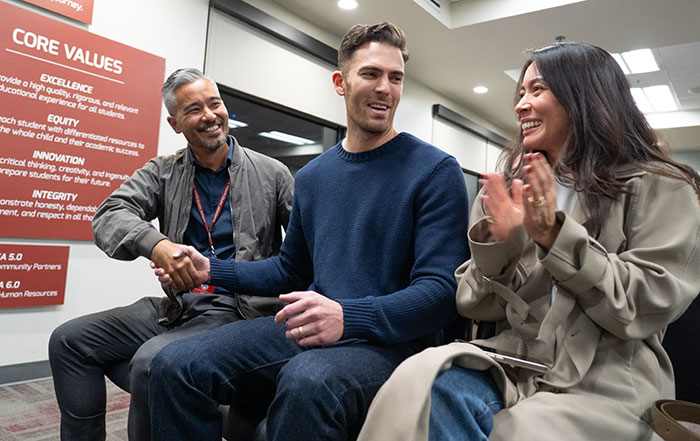Spike among Claremont teens who suffer from depression, suicidal thoughts
A troubling number of local teens struggle with depression and suicidal thoughts, Assistant Superintendent of Student Services Mike Bateman shared at the last meeting of the Claremont Unified School District.
This information—culled from a California Healthy Kids Survey administered by CUSD in the spring of 2012—was presented Thursday, just hours after CHS hosted its biennial Yellow Ribbon Suicide Prevention presentation.
Twenty-four percent of 7th graders at El Roble report having felt sad or hopeless during the past 12 months. This number consistently rises as Claremont teens get older, with 29 percent of CHS freshman graders and 34 percent of juniors saying they have grappled with sadness or hopelessness. At San Antonio High School and Community Day school reporting depression reached 40 percent.
The number of students in 9th and 11th grade who report having contemplated suicide in the past year prior to the survey was 17 percent for CHS 9th graders and 20 percent for CHS 11th graders. Students at San Antonio High School and Community Day School (SAH/CDS) fared somewhat better, with only 14 percent of students reporting that they had pondered taking their lives in the past 12 months.
“We’re aware of the high numbers,” Mr. Bateman said, emphasizing that district counselors and mental health interns from the University of La Verne have been appraised of the situation.
School board members like Hilary LaConte expressed concern at the numbers.
“That’s a lot of kids,” she said. “Maybe there’s a way to help get more caring adults on campus. Students that age are not necessarily talking to their parents, but they do talk to other adults.”
Mr. Bateman shared some of the partnerships through which the district is addressing student mental health issues, including training conducted by Tri-City Mental Health Center to help school staffers recognize the signs of depression early on.
“I think it’s very important to know: This is a community issue,” board president Jeff Stark noted. “This is one of those instances where we need to be working together to bring those numbers down across the board.”
In good news, students reported feeling quite safe at Claremont schools. The percent of 7th graders and CHS freshmen and juniors who said they feel very safe at school was 91 percent, 88 percent and 92 percent percent, respectively. Eighty-five percent of students at SAH/CDS reported feeling safe at school.
In general, student use of and approval of tobacco, alcohol and various drugs has declined over the last year, although there was a drop—from 96 percent to 85 percent—in the number of 5th graders who say they consider smoking marijuana to be “very bad for a person’s health.” Those gains were not the case for SAHS/CDS, where the number of students who reported having consumed alcohol or other drugs in the past 30 days rose from about 44 percent in 2010 to 62 percent in 2012.
CUSD is no longer required by the state to undertake the voluntary, anonymous California Healthy Kids Survey, which seeks to gauge the level of unhealthy and high-risk behaviors and attitudes among local students in grades 5 through 12. The district opted to administer the survey anyway, in order to better assess issues and needs among youths in CUSD.
Marantha Croomes, the student board member representing Claremont High School, attended the Yellow Ribbon Suicide Prevention presentation earlier in the day and had good things to say during her regular school board report.
“It was really moving to hear,” said Marantha. The program, she added—which included 2 speakers, one a CHS alumnus, who have lost loved ones to suicide—made students want to help out with any of their peers who may be facing a crisis.
The board was able to applaud a teen success story later in the meeting when Claremont High School art teacher Anne Mumper took the stage along with CHS students Isabella Mendoza, Samantha Mutschler, Ngoc Pham, Garrett Shipway and Julian To, taking a bow for a public art piece they undertook together an 8-by-8 foot ceramic tile mural installed on the façade of the Big 5 sporting goods store in Pomona.
During the public comment period, Sumner Elementary School teacher Joe Tonan took a moment to address the communicative health of the district, which he said has room for improvement. The Claremont Faculty Association has been pushing for members of the teachers union to be allowed to meet with school board members, one or 2 at a time, in order to share ideas, suggestions and concerns. Members of the board regularly grant this courtesy to administrators, but refuse to meet with teachers out of what Mr. Tonan characterized as “a misunderstanding of the Brown Act.”
The Ralph M. Brown Act, which was passed in 1953, guarantees the public’s right to attend and participate in meetings of local legislative bodies. As such, it is prohibited for the school board to meet en masse to discuss policy issues.
“Take a minute to look around the dais,” Mr. Tonan said near the conclusion of his speech. “Who are the stakeholder groups represented? There are board members up there, there are administrators up there, there is a classified employee up there, there are 2 students up there.”
“Many of you are parents in the district,” he continued. “The board needs to expand this table so that all voices are heard. I’m asking you tonight, please, to help prevent problems like we have had, to ensure better working relationships, to open the lines of communication and build a stronger, more unified school district.”
By contrast, Mr. Tonan congratulated Superintendent Jim Elsasser for his first hiring decision while on the job, the contracting of new Sumner Principal Kristin Robinson.
“You definitely made the right choice,” he said.
Mr. Tonan’s praise came during Sumner Elementary School’s presentation of its Single Plan for Student Achievement (SPSA). Required by No Child Left Behind mandates, an SPSA tracks a school’s progress towards goals set the previous year and outline its latest priorities.
With 98 office referrals during the 2011, 2012 school year, Sumner exceeded its goal of reducing the number of office referrals from 138 to 105. The school was only partially successful in meeting its academic goals, the Sumner delegation shared.
Ms. Robinson and her staff had aimed to up the percentage of students within significant subgroups scoring proficient or higher in the math portion of the CST. While scores did improve among Hispanic, White and socio-economically disadvantaged students, they fell short of the numbers they shot for.
Sumner had set a goal of the entire school as well as students in significant subgroups improving their performance in the English language arts portion of state testing. The percentage of Sumner students scoring proficient or higher on the CST increased by nearly 4 percentage points but missed the target goal of 79 percent proficiency. White students and socio economically disadvantaged students also made gains, but ELA proficiency among Hispanic students fell by some 5 percent.
After the Sumner delegation was done presenting its SPSA, the board took a moment to acknowledge some of the challenges Sumner has faced, including a high mobility rate among the socio-economically disadvantaged student population and last year’s sudden dismissal of a longstanding principal.
They also acknowledged the school’s strengths, emphasizing the lessons students learn by interacting with a diverse population, from the disabled students of the neighboring Danbury to a student body with a large spectrum of economic situations.
More on the Single Plans for Student achievements for Sumner and Danbury schools as well as San Antonio High School that were presented Thursday evening will be included in a future edition of the COURIER.
—Sarah Torribio
storribio@claremont-courier.com










0 Comments